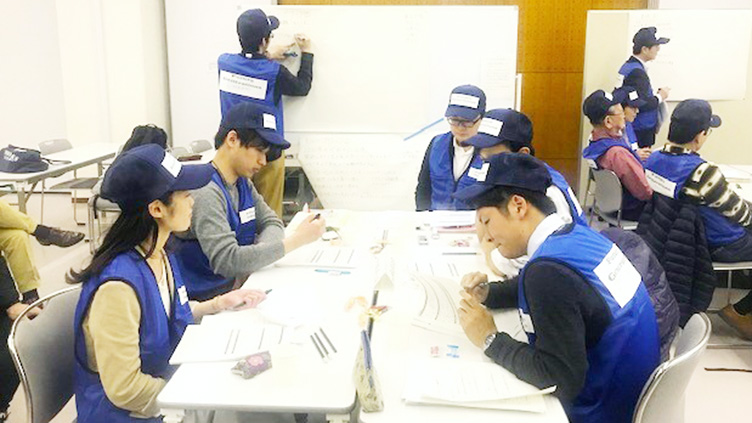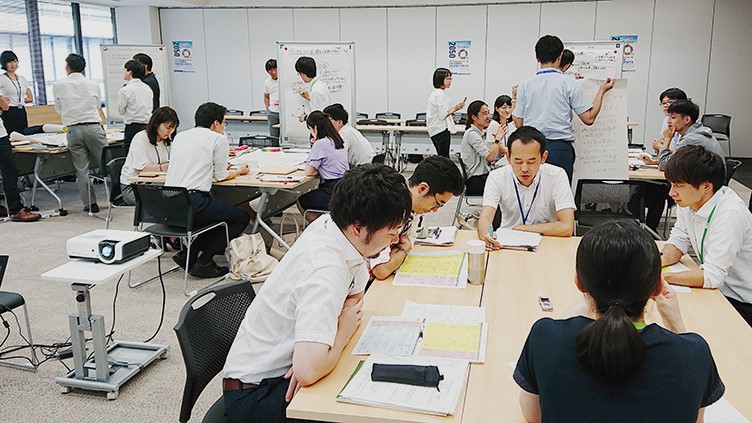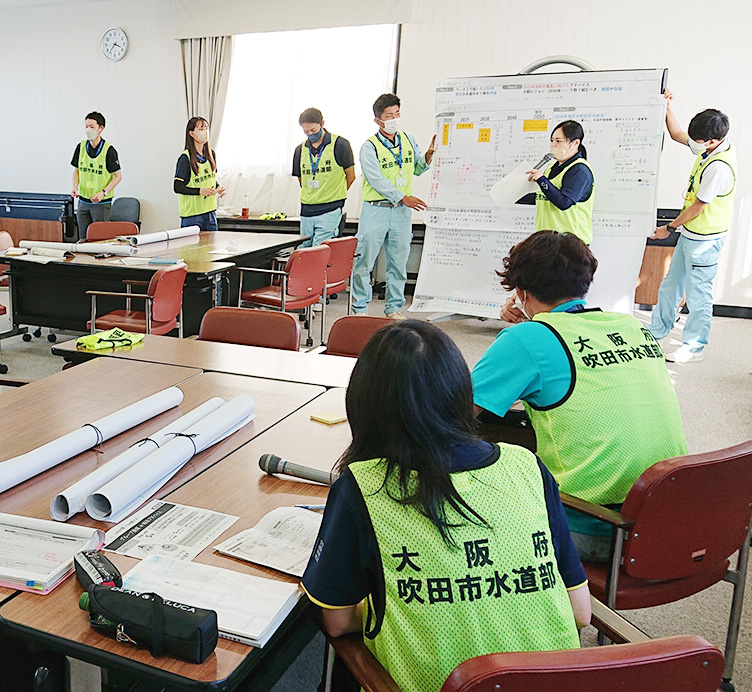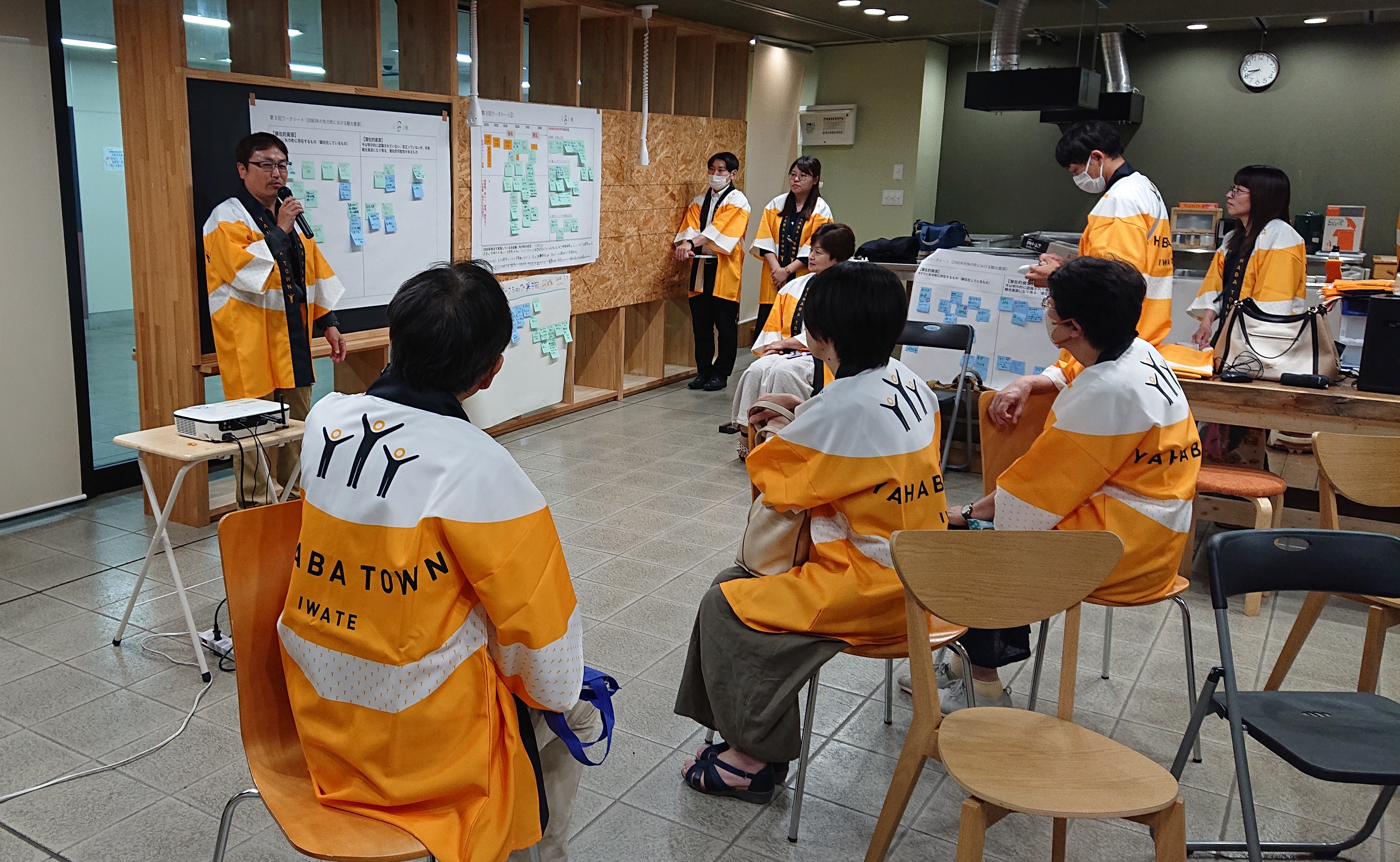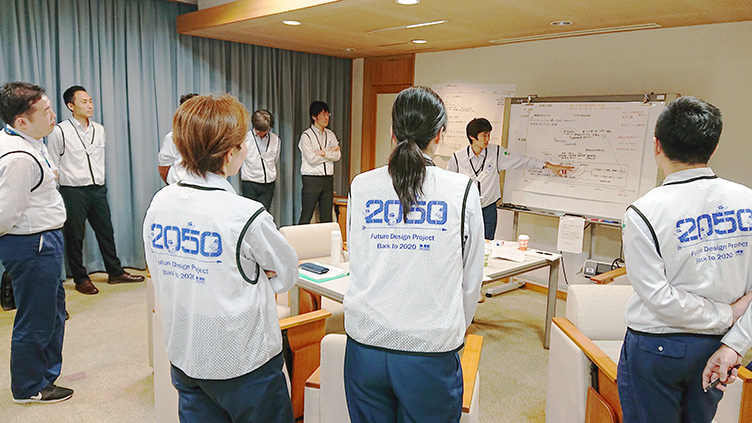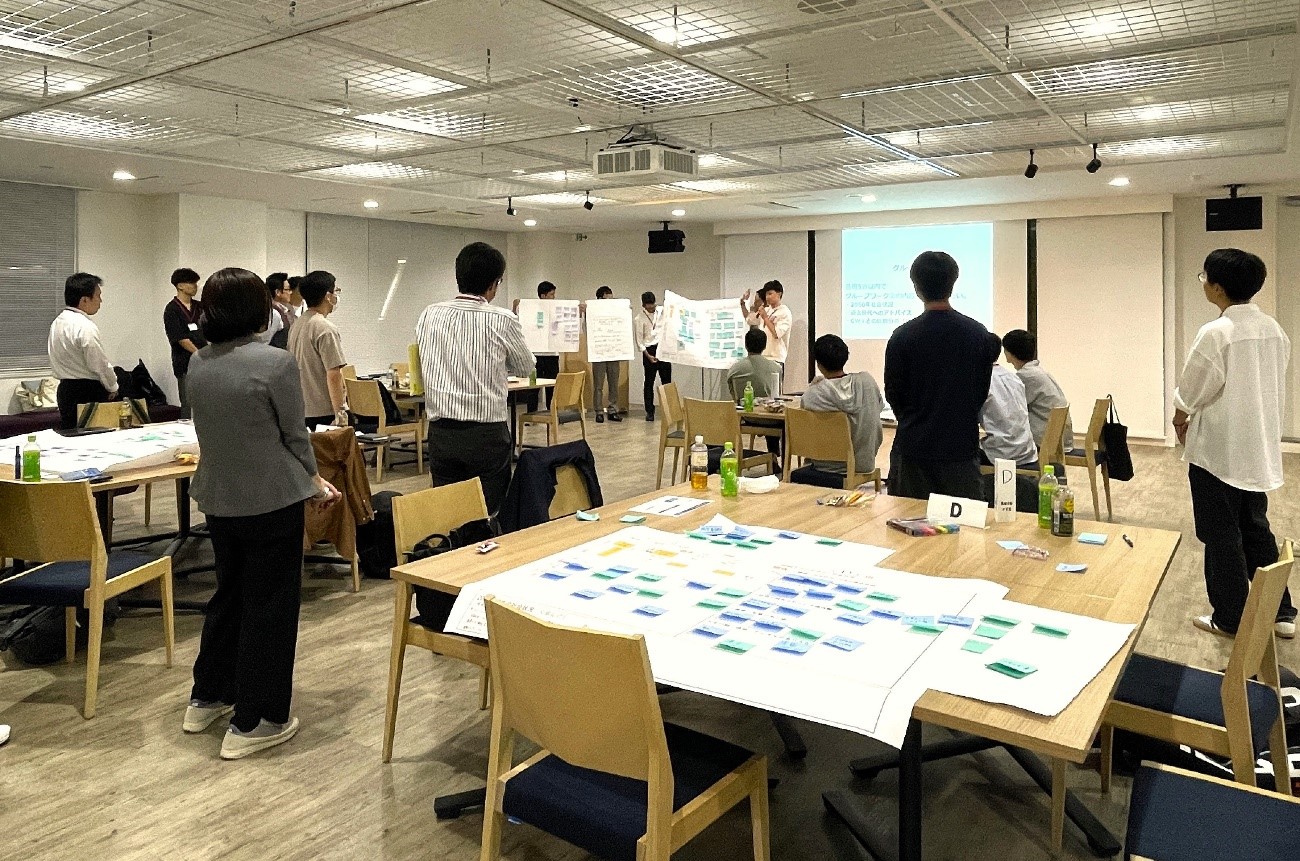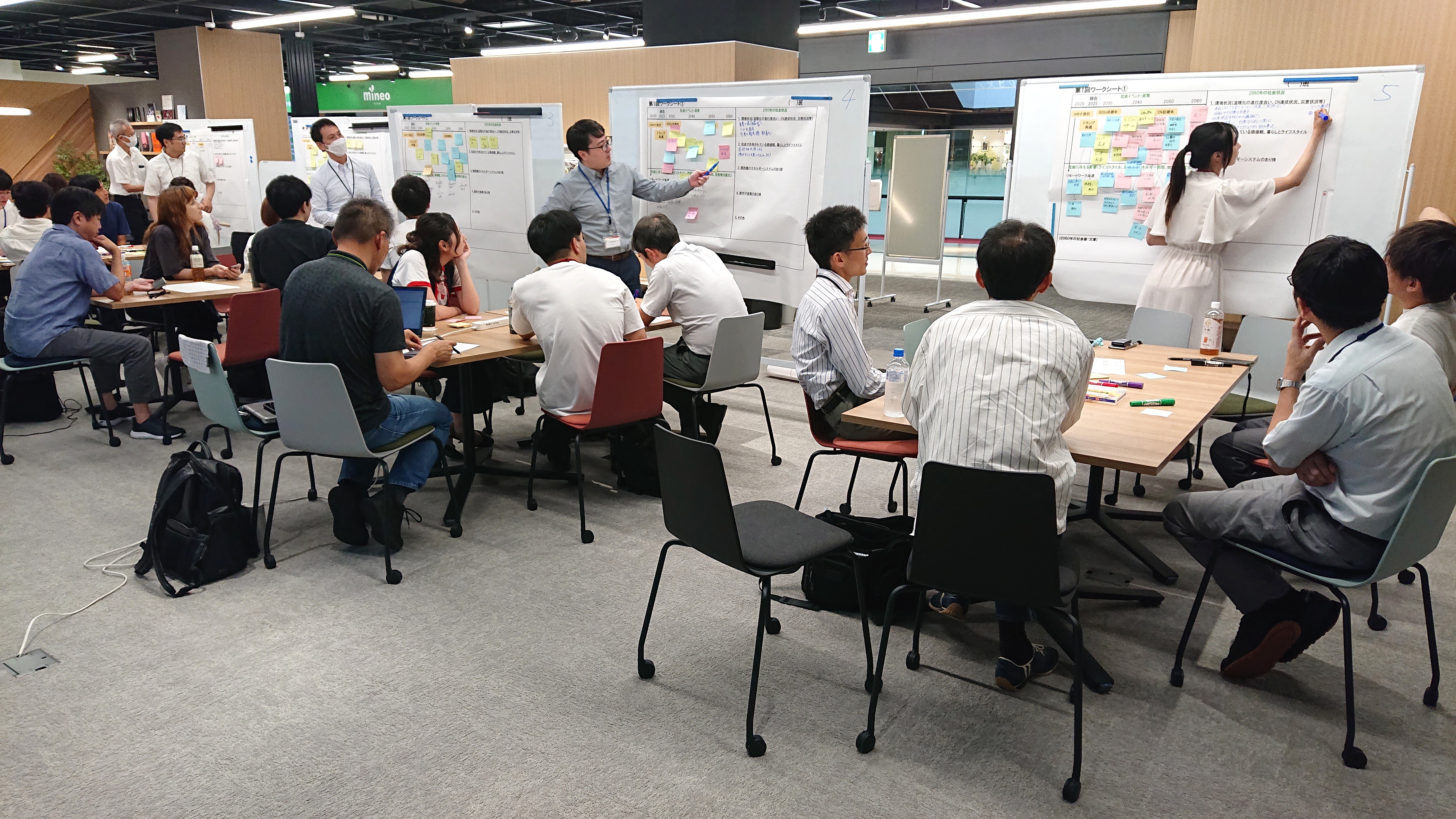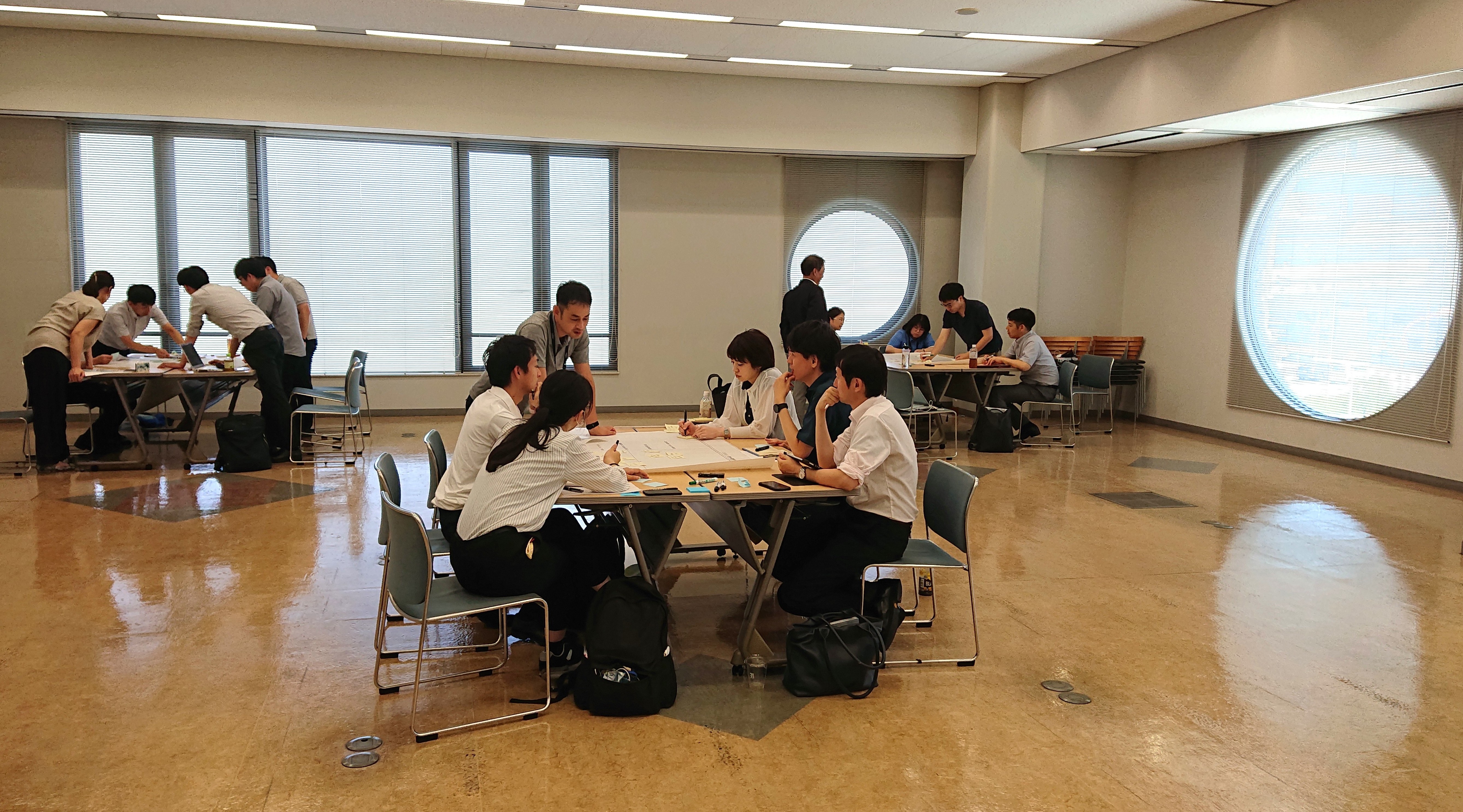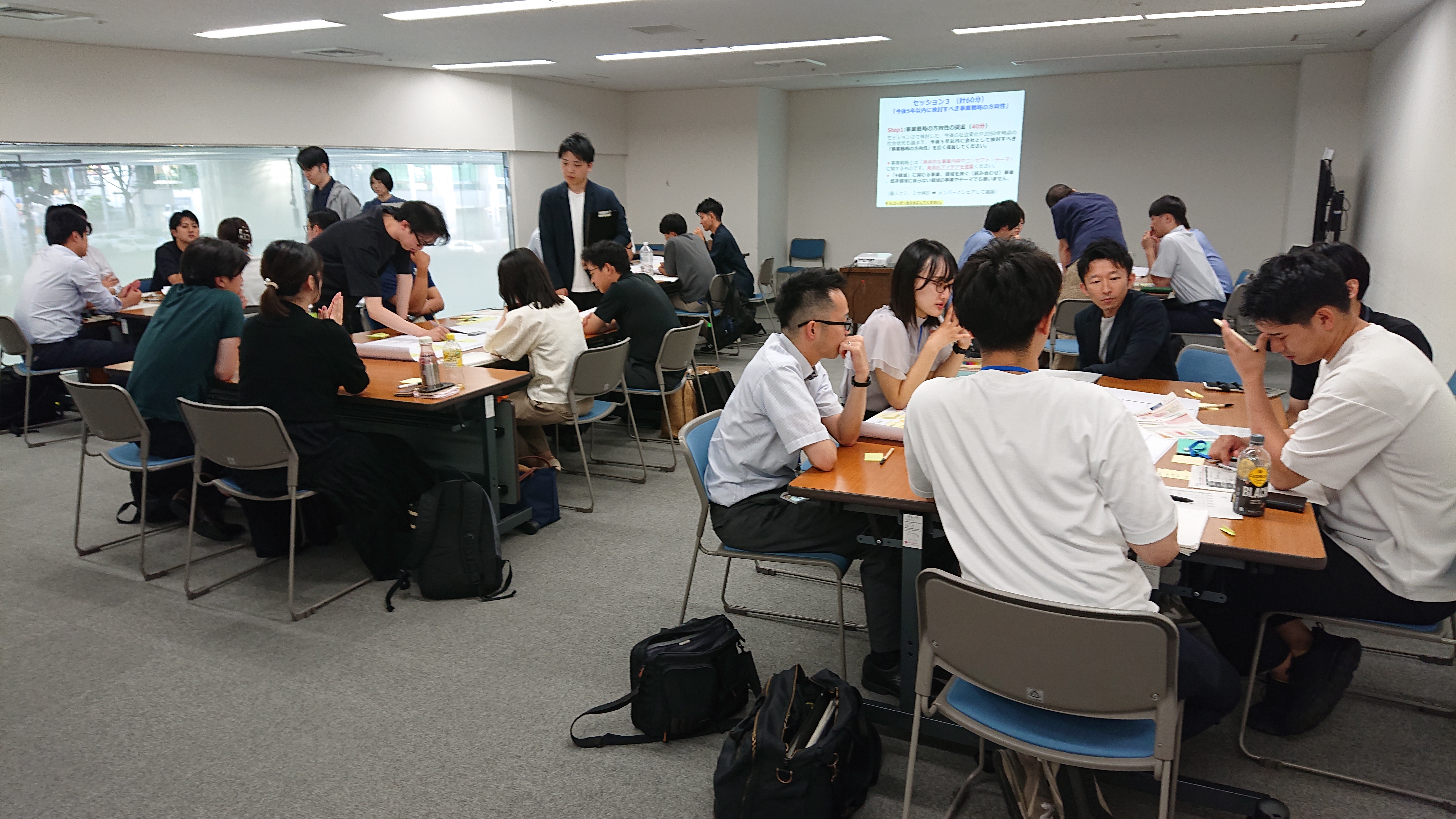 Center of Excellence in Advanced Research, TechnoArena
Center of Excellence in Advanced Research, TechnoArenaGraduate School of Engineering, Osaka University
Research Base for Future Design
This site presents 32 examples of Future Design practices in local government, national government, industry, and other sectors. These include Future Design practices that involve “collaboration” among diverse entities such as government agencies, local governments, industry, and research institutions. Our team has been leading Future Design practices, including the first one conducted in Yahaba town in 2015 (See details below). In particular, representative examples of the introduction of "Imaginary Future Generations (IFGs)," which is considered to be an effective method for sustainable decision-making, are presented with the theme of practice, entity responsible for implementation, and references. The cases below include those that were implemented prior to the establishment of the research base, as well as those implemented in conjunction with other universities and research institutions. The fields of Future Design practice include urban planning, public facility management, renewable energy, carbon neutrality, environmental planning, educational programs, water infrastructure maintenance, R&D strategies, business strategies, technology assessment, etc (See the details below). Since the concept of Future Design was first discussed and proposed by research members participating in the “Seven Generations Vision Project” at Osaka University in 2012, various social practices have been developed. Future Design has been practiced in the public policy fields and industrial sectors.
This website (only in Japanese) provides a concise description and publication of the basic steps and conditions of Future Design practice, based on the findings from research and practices of Future Design which was first conceived in the research meeting "Seven Generations Vision Project" at Osaka University. At Osaka University, we have not promoted a generalized manual for the methodology of Future Design practice, but rather have derived a methodology that is tailored to individual issues in situations where practitioners and researchers have collaborated. We believe that this is also important in terms of building up academic knowledge in the new academic field of Future Design. Please contact us if you are interested in Future Design practice or collaborative research.
Practices in Public Policy
local governments, public institutions, research institutions, and industry members
━━ Case:01
Regional Revitalization Plan/Urban Planning
Yahaba Town, Iwate Pref. / 2015
This is the first practice of Future Design implemented based on a partnership agreement between Osaka University and Yahaba Town with the support from Japan Science and Technology Agency (JST) RISTEX (PI: Keishiro Hara), in which "Imaginary Future Generations" was applied to visioning and decision-making in the real world. In this practice, participating citizens were divided into two groups: a ‘Imaginary Future Generations (IFGs)’ group representing the year 2060 and a ‘current generation’ group. They first discussed regional revitalization plans separately, and then paired up with each other to reach consensus and negotiate. This practice revealed that the decision-making criteria and social change incentives of the IFGs group were different from those of the current generation group. This case is the first practice where decision-making for social problem solving and vision creation was carried out by adopting IFGs, a stakeholder of future generations. This case study is the first to demonstrate the effects of introducing a “Imaginary Future generation” on people's decision-making and social consensus building, and became the basis for Future Design practices that have since spread. It has been featured not only in domestic media but also in foreign newspapers such as BBC and Washington Post. After these practicec of Future Design, Yahaba Town established a "Future Strategy Section" with the role of implementing Future Design in policy making, and has begun new initiatives such as an assessment of policy making (e.g., urban planning) from the perspective of future generations.
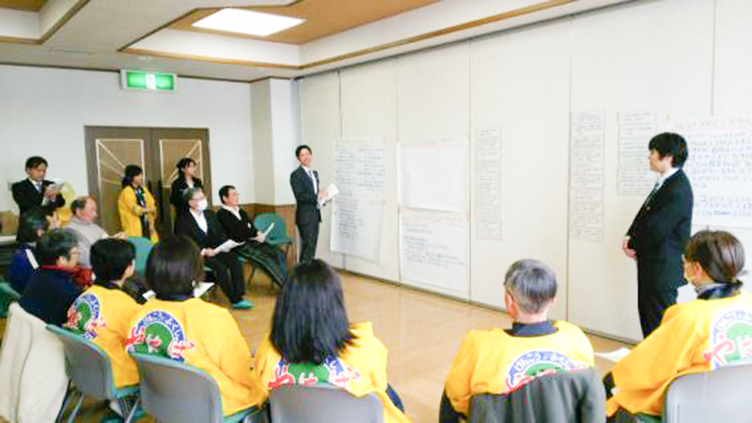
Reference
─
- Hara K, Yoshioka R, Kuroda M, Kurimoto S, Saijo T, Reconciling intergenerational conflicts with imaginary future generations - Evidence from a participatory deliberation practice in a municipality in Japan, Sustainability Science, 14(6), 1605-1619, 2019
https://doi.org/10.1007/s11625-019-00684-x
- Foreign Affairs"The Beginning of History"
- "The Promise of Future Design"released by The School of International Futures
- Article featured in Washington Post
━━ Case:02
Planning of Public Facilities and Housing
Yahaba Town,Iwate Pref. / 2017
In this practice, all participants experienced both the positions and perspectives of the current generation and the Imaginary Future Generations (IFGs), and then adopted a method to achieve long-term decision-making by making final decisions. This method is also applied in many Future Design practices. Specifically, in the first time, everyone considered and decided on measures for public facility management and municipal housing plans from the perspective of the current generation, in the second time, they considered and decided on the same content as IFGs, and in the third time, they could choose either perspective, but they made a final decision by explicitly stating the reasons for their decision and advice to future generations. This is a three-step method. From this practice, it has become clear that many participants have formed a higher perspective that shares both the perspectives of the current generation and future generations (viewpoint sharing).
In Yahaba Town, after experiencing Future Design practices in 2015 and 2017, Future Design with citizen participation was applied to the formulation of the “comprehensive plan”, which is the main administrative plan of the town, in 2019.
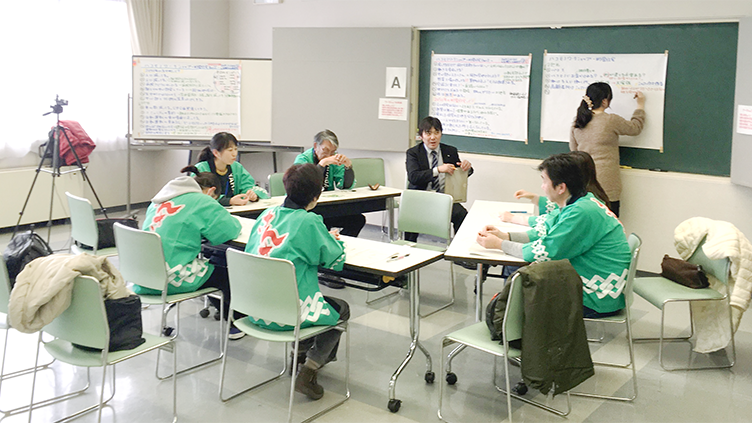
Reference
─
- Hara K, Kitakaji Y, Sugino H, Yoshioka R, Takeda H, Hizen Y and Saijo T, Effects of Experiencing the Role of Imaginary Future Generations in Decision-Making - a Case Study of Participatory Deliberation in a Japanese Town, Sustainability Science, 16(3), 1001-1016, 2021
https://doi.org/10.1007/s11625-021-00918-x - Article featured in BBC
━━ Case:03
Visioning of Introducing Renewable Energy
Suita City, Osaka Pref. / 2016-2017
In Suita City, future design was implemented with citizen participation on vision creation for 2050 and introduction of renewable energy. In this practice, a new methodology that combines backcasting and Imaginary Future Generations (IFGs), which is the central methods of future design, was applied. As a result of discussions and decision-making using this method, four future society visions related to the diffusion of renewable energy in Suita City were described. In addition, a mechanism that can calculate CO2 emissions quantitatively according to the depicted social image was also introduced.
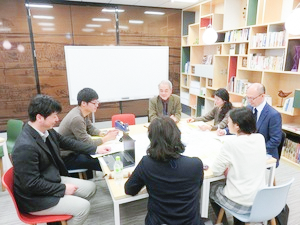
Reference
─
- Uwasu M, Kishita Y, Hara K and Nomaguchi Y, Citizen-participatory Scenario Design Methodology with Future Design Approach: A Case Study of Visioning for Low-Carbon Society in Suita City, Japan, Sustainability, 12(11), 4746, 2020
https://doi.org/10.3390/su12114746
━━ Case:04
Workplace Reform and Business Improvement
Ministry of Economy, Trade and Industry / 2019
A Future Design practice was conducted by young staff members who examined the business reform of the Ministry of Economy, Trade and Industry, with themes such as work style reform and business improvement. Based on current policy issues and evaluation analysis of past policies, measures to be taken from now on were discussed from both perspectives of the current generation and Imaginary Future Generations (IFGs).
Reference
─
━━ Case:05
Policy Design for Basic Environmental Planning
Suita City, Osaka Pref. / 2019
In this practice, Future Design was applied to the discussion for formulating the city’s third basic environmental plan. Citizens selected by public recruitment and city hall staff formed six groups and discussed four times. The “social image of Suita City in 2050” and “policy options to be adopted in the future” were examined from both perspectives of the current generation and Imaginary Future Generations (IFGs), and each group made final policy proposals and policy evaluations. The ideas and ways of thinking raised in this practice are also referred to in the city’s plan formulation.
In addition, from the data obtained from this practice, it was suggested that by introducing a mechanism of virtual future generation, cognition such as “a sense of crisis about the future” and “a shared recognition of goals that are desirable for society as a whole” may increase regardless of individual characteristics such as Critical Thinking."
Reference
─
- Hara K, Naya M, Kitakaji Y, Kuroda M, Nomaguchi Y, Changes in Perception and the Effects of Personal Attributes in Decision-making as Imaginary Future Generations: Evidence from participatory environmental planning, Sustainability Science, 18, 2453?2467, 2023
https://doi.org/10.1007/s11625-023-01376-3
━━ Case:06
Policy Design for Carbon Neutrality
Kyoto City / 2019
In this practice, 25 city employees, selected from an open competition, worked as a team to conduct five sessions of Future Design for Policy Design with the goal of achieving carbon neutrality in Kyoto City in 2050. From the perspective of Imaginary Future Generations (IFGs), city employees proposed and selected a vision of a carbon-neutral Kyoto City in 2050 and measures that should be implemented by 2030. In this practice, a "Causal Loop diagram" was used to systematically understand the relationships among the various elements and measures that make up the vision of society in 2050. Some of the images of society in 2050 created through this practice are also reflected in the administrative plan.
Reference
─
- Hara K, Nomaguchi Y, Fukutomi S, Kuroda M, Fujita K, Kawai Y, Fujita M and Kobashi T (2022) Policy Design by “Imaginary Future Generations” with Systems Thinking ? a Practice by Kyoto City towards Decarbonization in 2050, Futures, 154, 103272, 2023
https://doi.org/10.1016/j.futures.2023.103272 - Nomaguchi Y, Senoo R, Fukutomi S, Hara K, Fujita K, Utilization method and effect evaluation of systems thinking in Future Design: Comparative analysis of policy-making workshops in local governments, International Journal of Automation Technology, 17(2), 183-193, 2023
https://doi.org/10.20965/ijat.2023.p0183 - Report by Kyoto City (in Japanese)
━━ Case:07
Sustainable Maintenance of Water Supply Infrastracture
Suita City, Osaka Pref. / 2022
Sustainable maintenance and management of social infrastructure, including water supply and sewage systems, is an important and urgent issue for the national and local governments. The Suita City Waterworks Department, with the participation of its employees, undertook a future design project to envision the state of the city's waterworks in 2050, identify issues to be considered for the next vision, and examine the direction of efforts to be made. In particular, the ideal state of the city's waterworks in 2050 and the measures that will be required in the future were designed from the perspective of future generations. This practice showed that the introduction of a method of Imaginary Future Generations (IFGs) increased awareness of crisis and the need for quick response, and also changed policy priorities and the direction of measures. In addition, in FY2022, Suita City Waterworks Department and Hara Laboratory, Graduate School of Engineering, Osaka University jointly conducted a questionnaire survey of 2,000 households in the city (randomly selected) to verify the significance and effectiveness of introducing the mechanism of IFGs in relation to awareness of issues and measures for water infrastructure maintenance and management.
In collaboration with local governments and others, this Research Base is also pioneering an assessment method to evaluate sustainable infrastructure maintenance and management by introducing Future Design.
Reference
─
- Hara K, Ikenaga T, Arai T, Fuchigami Y, Policy Design and Decision Criteria for Sustainable Water Supply from the Perspective of “Imaginary Future Generations” - A Deliberation Experiment with Policymakers in a Municipality, Japan, Futures, In press, 103618, 2025
https://doi.org/10.1016/j.futures.2025.103618 - Fuchigami Y, Ikenaga T, Kuroda M, Hara K, Thinking from the Perspective of Imaginary Future Generations Changes the Public Perception of Sustainable Management of Water Supply Infrastructure – A Large-scale Questionnaire Survey in a Municipality of Japan, Futures, 175, 103709, 2025
> https://doi.org/10.1016/j.futures.2025.103709 - Aoki N, Fuchigami Y, Hara K, Effectiveness of Future Design in Planning and Evaluation of Maintenance and Management of Water Supply Infrastructure-A practice of Administrative Officials in Suita City, Osaka Prefecture, EcoDeps 2024(in Japanese)
- Ikenaga T, Fuchigami Y, Kuroda M, Hara K, Effects of adopting Imaginary Future Generation on water supply infrastructure maintenance problem-Large scale questionnaire survey in Suita city, Osaka Prefecture, Ecodeps 2022 (in Japanese)
- Report by Suita City (in Japanese)
━━ Case:08
Scenario Evaluation for Renewable Energy Technology and Policy Design for Carbon Neutrality
Suita City, Osaka Pref. / 2022
The Environmental Policy Office of Suita City conducted a policy formulation practice (training) for the realization of carbon neutrality in 2050 based on Future Design with the participation of city employees. The participants described the social vision of Suita City in 2050 from the standpoints of current generation (current city employees) and the Imaginary Future Generations (IFGs) in 2050, respectively, and identified and selected measures to be implemented by 2030. The measures selected from the perspective of the IFGs showed various changes in content and quality compared to those proposed from the perspective of current employees, indicating the effectiveness of adopting IFGs.
In implementing this practice, information from the scenario evaluation of the diffusion of renewable energy technologies was also used. First, a team of researchers constructed multiple scenarios in which promising technologies such as electric vehicles (EV), photovoltaic (PV), and V2H spread to Suita City in 2030 and 2050, and conducted simulations using models to evaluate the effects of technology diffusion on five indicators, including cost reduction and carbon emission reduction. The results were used to evaluate the effects of technology diffusion on five indicators, including cost reductions and carbon reductions. One of the features of this Future Design practice is that carbon neutral policies were examined based on such objective data and information on future projections of technology diffusion.
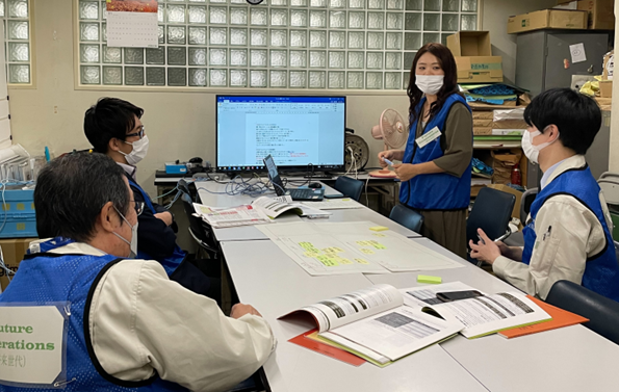
Reference
─
- Iwasaki Y, Kobashi T, Fuchigami Y, Hara K, Future Scenarios and Assessment of Gradual Diffusion of Renewable Energy Technologies towards 2050: Case Study of a Japanese Municipality, SSRN (preprint), 2023
http://dx.doi.org/10.2139/ssrn.4674824 - Hara K, Iwasaki Y, Fuchigami Y (2024) Policy Choices and Individuals' Attitudes from the perspective of Imaginary Future Generations—A Discussion Experiment with City Officials on Carbon Neutrality, SSRN (preprint), 2024
http://dx.doi.org/10.2139/ssrn.5053297 - Iwasaki Y, Fuchigami Y, Hara K, Effects of Introducing Imaginary Future Generations on Policy Decisions Toward Carbon neutral: Deliberation Practice in Suita City, Ecodeps 2022 (in Japanse)
━━ Case:09
Assessment of administrative plans (Urban planning)
Yahaba Town, Iwate Pref. / 2015
In the public policy field, the practice of evaluating administrative plans from the perspective of sustainability and long-term perspectives and improving plans is an important issue. Future Design could be applied to assess the impact of current plans and policies on future generations in a more concrete and multifaceted way.
From August to November 2023, the town of Yahaba applied Future Design to implement an evaluation for the revision of urban planning master plan and identify measures to improve the master plan. A total of 21 staff members from nine departments and offices of the town hall participated in the practice and were divided into four groups - two groups of the current generation and two groups of the Imaginary Future Generations (IFGs) - to evaluate the master plan from the perspective of the current and future generations. In the first three sessions, the four groups separately evaluated the master plan and proposed measures, and in the fourth and final session, one group each from the current and IFGs paired up to form a consensus and propose five specific measures to improve the plan. A particular feature of this practice was that the discussion focused on trade-off issues that are difficult to resolve only from the perspective of current generation, such as the issue of disparities between urban development and rural areas, and that the assessment was carried out by incorporating the perspectives of both the current and future generations.
As a result of the practice, differences between the current generation group and the future generation group were clearly observed in terms of the focus of urban planning issues, issue setting, evaluation results and policy proposals. In particular, the IFGs tended to describe a more concrete image of the future society of the town in 2050 and to focus on essential issues for the town, such as the potential risk of the problem of labour shortage in rural areas.
This initiative is the first example of Future Design being applied to the assessment of an administrative plan, and proposes a new method of assessing administrative plans from the viewpoint of sustainability. By incorporating the perspectives of both current and future generations in the assessment, it could also lead to the development of a new method for the assessment of administrative planning and policy-making that explicitly incorporates a time horizon.
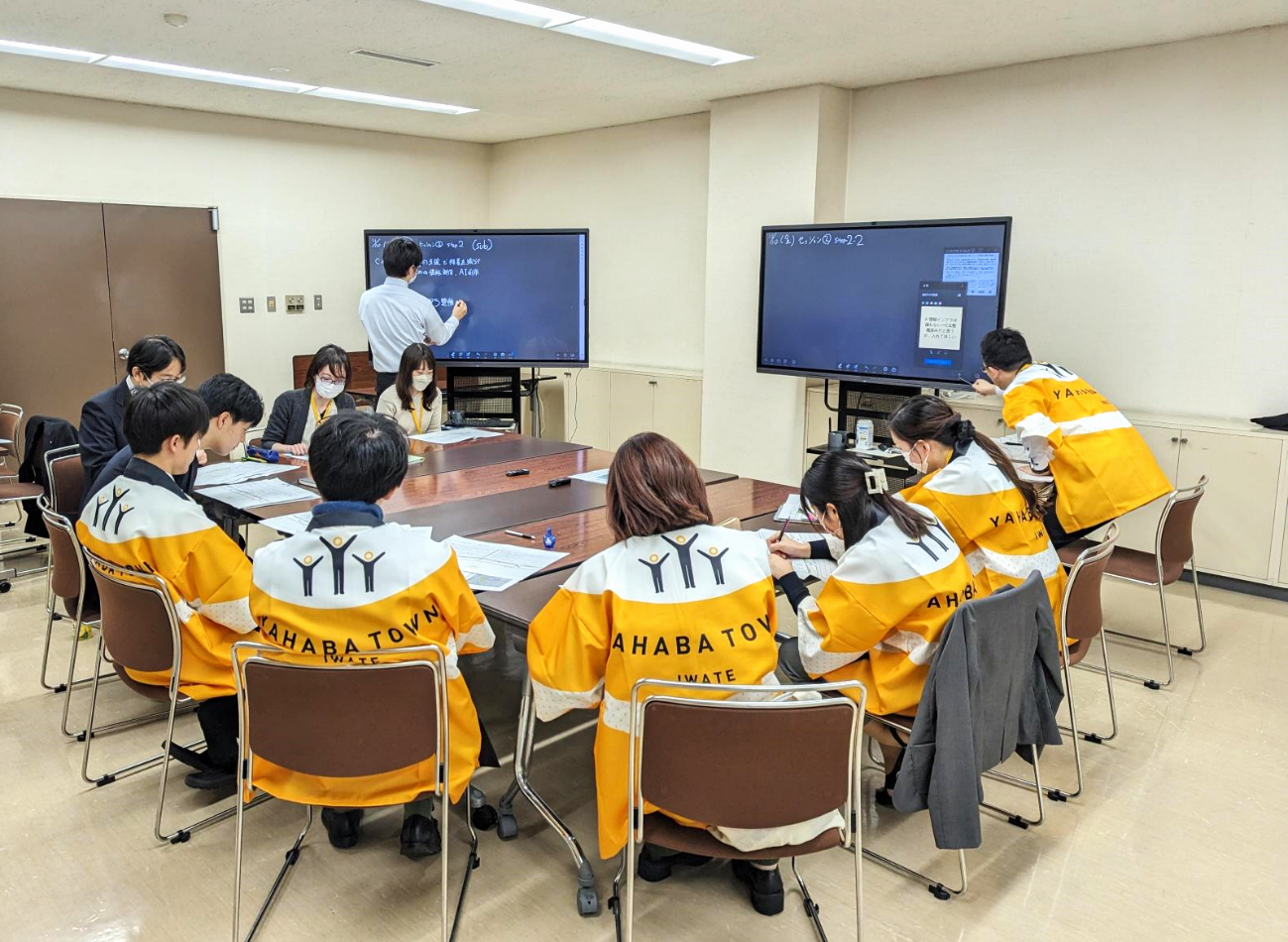
Reference
─
- Hara K, Application of Future Design to Policies: Insights from the practices adopting "Imaginary Future Generations", RIETI Special Report, 2024
https://www.rieti.go.jp/en/special/policy-update/113.html
━━ Case:10
Energy Supply and Demand and Prevention of Global Warming / 2023
The 19th "Kinki Regional Committees on Energy Supply and Demand and Prevention of Global Warming" held on December 19, 2023, was attended by the Kinki regional government, local governments, energy professionals, universities, and research institutions. The participants exchanged opinions applying Future Design under the theme of carbon neutrality in 2050. They discussed the lifestyle policies that individuals and organizations should realize within 10 years from the standpoint of the Imaginary Future Generations, in addition to the images of society in 2050. In particular, the opinions of the Imaginary Future Generations included not only those related to energy and global warming countermeasures, but also a variety of other issues, such as the realization of a three-hour workday in line with technological development and the implementation of environmental conservation activities using surplus time.
In order to realize a carbon-neutral society, it is necessary for diverse stakeholders to work together to build consensus on the measures and paths to be taken in the future. Future Design may help promote discussion and consensus building among diverse stakeholders by incorporating the perspectives of future generations, and related research and practices have been initiated.
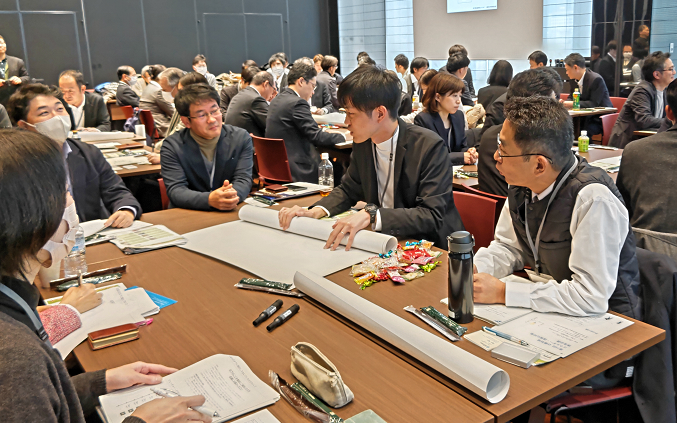
Reference
─
- In preparation
━━ Case:11
Study of policies on water environment issues - the case of Ho Chi Minh City
Ho Chi Minh City, Vietnam / 2017
In February 2017, 47 students and researchers (teachers) participated in a workshop at Ho Chi Minh City University of Technology to examine the current and future issues of water environment problems in Ho Chi Minh City. The results of the questionnaire survey administrated to participants showed that, compared to when the issues were examined from the perspective of current generation, when examined as Imaginary Future Generations (IFGs),the participants tended to shift their focus from measures that lead to short-term benefits to those that help solve long-term issues, such as the impact of human activities on global environmental problems. The study also suggested that the way in which the visions of future society were envisioned was related to the effectiveness of adopting IFGs. Future Design practices in various countries and regions are also expected to become important.
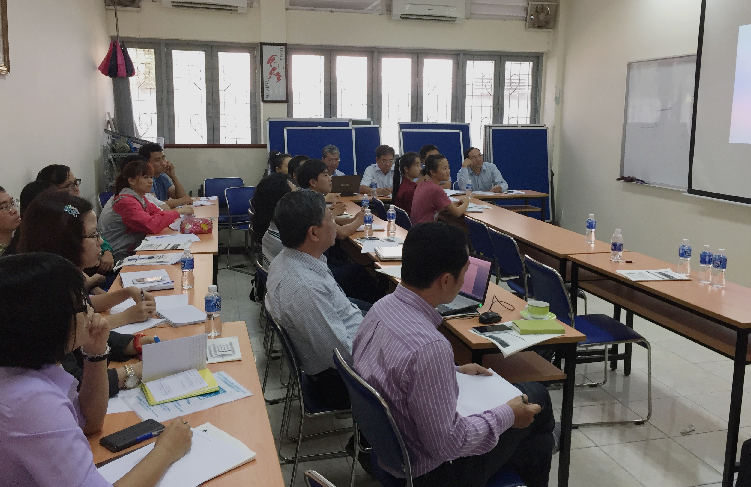
Reference
─
- Kuroda M, Uwasu M, Bui X.T, Nguyen P.D, and Hara K, Shifting the Perception of Water Environment Problems by Introducing “Imaginary Future Generations - Evidence from participatory workshop in Ho Chi Minh City, Vietnam, Futures, 126, 102671, 2021
https://doi.org/10.1016/j.futures.2020.102671
━━ Case:12
Inter-municipal Wide Area Collaboration and Integrated Measures for Carbon Neutrality and Disaster Prevention
Nishinomiya City; Amagasaki City; Toyonaka City; Suita City; METI Kansai Bureau of Economy, Trade and Industry; Kinki Regional Environment Office, Ministry of the Environment / 2024
Four local governments (Nishinomiya City, Amagasaki City, Toyonaka City, Suita City) and government agencies in the Kinki region in Japan have collaborated to start a Future Design that considers wide area collaboration strategies and integrated measures for carbon neutrality and disaster prevention, looking ahead to the society of 2060. In order to address long-term policy issues such as carbon neutrality, wide area collaboration strategies, including inter-municipal collaboration, will become increasingly important. In addition, by discussing integrated measures that capture carbon neutral policies and disaster prevention policies, which have been discussed individually in the past, there is a possibility that it will lead to more effective policy planning. This Future Design practice is a new initiative in which staff of participating organizations consider these themes from the perspective of Imaginary Future Generations.
As Japan and the world face various sustainability issues and long-term challenges, this initiative could be a leading example of envisioning a sustainable future society based on academic insights of Future Design, looking at inter-organizational collaboration, and policies for it.
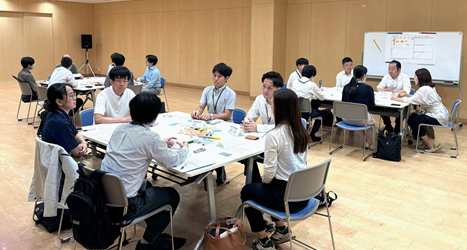
Reference
─
- Sugita Y, Okuda M, Fuchigami Y, Hara K, Effects of Future Design in the Consideration of Integrated Policies of Carbon Neutrality and Disaster Prevention – An Deliberation Experiment Involving Policy Makers, EcoDeps 2024(in Japanese)
- Okuda M, Sugita Y, Fuchigami Y, Hara K, Examining the Effects of Future Design on Enhancing Inter-organizational Collaboration, EcoDeps 2024(in Japanese)
━━ Case:13
Climate Change Adaptation and Mitigation Measures and Resilient Urban Development
Mito City, Ibaragi Pref. / 2024
In this practice, officials from 22 divisions of Mito City Hall in Ibaraki Prefecture have been discussing climate change adaptation and mitigation measures as well as the vision for a resilient future society, looking ahead to 2060. This practice is being carried out in collaboration with Global and Local Environment Co-creation Institute (GLEC) of Ibaraki University, which is conducting research on climate change adaptation strategies. Based on scientific insights related to the implementation of adaptation measures, officials are examining policies that should be implemented in Mito City by 2030.
In urban areas, the consideration of adaptation measures to prepare for disasters such as heavy rainfall is becoming increasingly important. This practice specifically discusses concrete policy issues that require a long-term perspective, including riverbank protection, mass relocation, and compact city planning. It serves as a pioneering example of climate change adaptation and mitigation strategies particularly in urban settings.
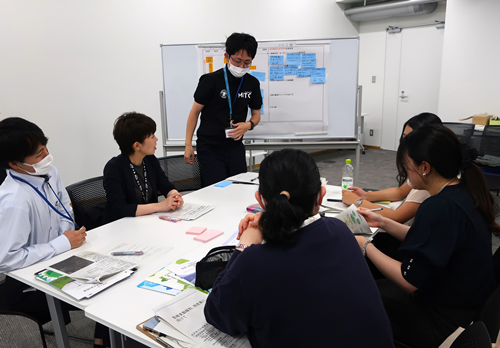
Reference
─
- Kazuma Hirota, Akihiko Kotera, Makoto Tamura, Keishiro Hara (2025) Planning and Evaluation of Climate Change Mitigation and Adaptation Measures from the Perspective of Imaginary Future Generations, Proceedings of EcoDesign 2025
- Hirota K, Fuchigami Y, Kotera K, Tamura M, Hara K, Effects of Future Design in Formulating and Evaluating Climate Change Mitigation and Adaptation Policies-A Case Study of Discussion in Mito City, Ibaraki Prefecture, Japan, EcoDeps 2024(in Japanese)
- Report on the workshop 1 (In Japanese)
- Report on the workshop 2 (In Japanese)
━━ Case:14
Youths discuss Sustainable Future and Propose Environmental Policies
Hyogo Pref. / 2024
As part of the revision of the “Fifth Basic Environmental Plan,” Hyogo Prefecture held the “Hyogo Environment Future Conference” with the cooperation of the Institute for Global Environmental Strategies, where the younger generation in particular took the lead in broad discussions on the future of society and the measures and policies that should be taken in the future. Keishiro Hara Laboratory, Graduate School of Engineering, Osaka University, provided academic support about Future Design, and discussions were conducted with the introduction of Future Design in the conference.
This conference was held in June 2024 at three venues in Toyooka, Kobe, and Himeji, with a total of 67 participants. Another significant feature of this conference is that over 70% of the participants were high school and university students (from 9 high schools and 3 universities in the prefecture).
Participants were divided into 14 groups in the three cities to discuss the three themes of “decarbonization,” “coexistence with nature,” and “resource recycling,” describing the state of society in 2050 and proposing measures to be taken by 2030, both from the perspective of Imaginary Future Generations. Participants who examined the issue from the perspective of the Imaginary Future Generation raised the importance of “implementing human resource development and educational programs,” “the importance of R&D and technological development,” and “concrete mechanisms to materialize policies,” and offered many concrete measures and advice.
Studies on Future Design suggests that considering and making decisions from the perspective of future generations will increase the sense of crisis and shared social goals related to the future, and will increase incentives for social change. In this Future Design practice, we observed comments and proposals related to these characteristics from the participants, and it seemed to be a valuable opportunity for the participants to think about the sustainable future of Hyogo Prefecture and to share it with others.
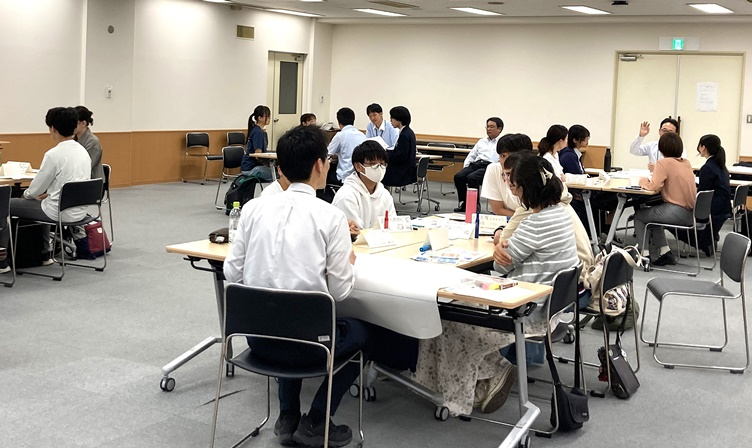
Reference
─
- Official document by Hyogo Prefecture about application on Future Design (In Japanese)
━━ Case:15
Policy proposal toward carbon neutrality through collaboration among government agencies, local governments, public institutions, research institutions, and industry members
Future Design Subcommittee, Kinki Regional Committees on Energy Supply and Demand and Prevention of Global Warming / 2024
The Kinki Regional Committees on Energy Supply and Demand and Prevention of Global Warming established the “Future Design Subcommittee for Carbon Neutrality” in FY2024. This is believed to be the first time a government body has established a subcommittee for the purpose of the practice of Future Design. In this subcommittee, diverse actors from industry, academia, and government discuss measures that should be taken by the current generation from the perspective of Imaginary Future Generations (IFGs) in order to create a catalog of various measures (ideas) for the realization of carbon neutrality in 2050.
The subcommittee has participants from 22 organizations in industry, academia, and government, including government agencies, local governments, public institutions, research institutions, and industry (see below), and is promoting discussions on policy adopting Future Design. The participants, as IFGs in 2050, are considering the social situation of the Kinki region in 2050 and measures that should be taken from 2024 through three workshops. Hara Laboratory at Osaka University is providing technical support in this subcommittee from the theoretical perspective of Future Design.
As mentioned above, this is the first practical case in which a government conference body has discussed measures and policies based on the Future Design concept and method with the participation of various sectors. What makes this case unique is that diverse actors from industry, academia, and government, while making use of their respective expertise and positions, overcame organizational frameworks and barriers to discuss a “new direction of innovation” with a view to achieving carbon neutrality, a common social goal.
[Reference]Participating Organizations in the Future Design Subcommittee for Carbon Neutrality
Kansai Bureau of Economy,Trade and Industry.(METI Kansai);Ministry of the Environment Kinki Regional Environment Office; Ministry of Land, Ministry of Land, Infrastructure、Transport and Tourism Kinki Regional Development Bureau
Shiga Prefecture; Kyoto Prefecture; Osaka Prefecture; Hyogo Prefecture
Osaka City; Suita City; Kobe City
Shiga Global Warming Prevention Activity Promotion Center; Kyoto Global Warming Prevention Activity Promotion Center; Osaka Global Warming Prevention Activity Promotion Center
Research Institute of Innovative Technology for the Earth
Kansai Economic Federation; Osaka Chamber of Commerce and Industry;Kansai Electric Power Co., Inc; Osaka Gas Co.,Ltd;
Panasonic Operational Excellence Co.;Ltd.; Patagonia,Inc (Japan);
Altalena Co.,Ltd / Value way Co., Ltd ; Members Co., Ltd.
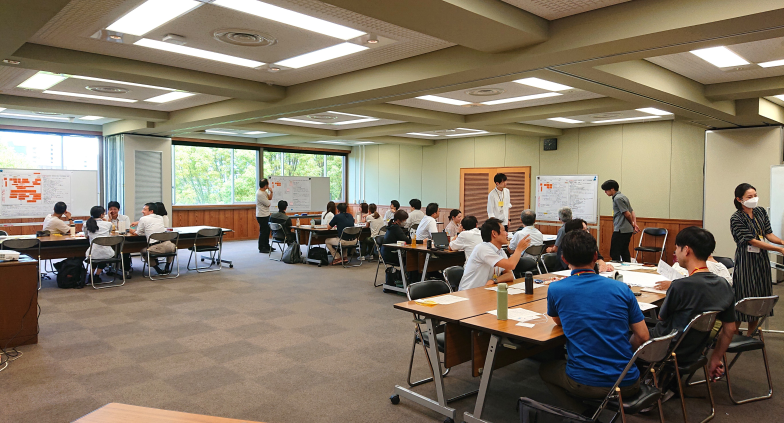
Reference
─
- Hara K, Future Design and Industrial Innovatoin, , RIETI Special Report, 2024
https://www.rieti.go.jp/en/special/policy-update/118.html
━━ Case:16
Evaluation of local and tourism resources, and designing policies with the participation of residents
Yahaba Town, Iwate Pref. / 2025
Examining and evaluating regional and tourism resources and utilizing them for future town development is essential for enhancing the appeal and sustainability of towns. In this initiative, the Industrial Tourism Division of Yahaba Town, Iwate Prefecture, and the Hara Laboratory at the Graduate School of Engineering, The University of Osaka, collaborated to conduct a multi-faceted examination of Yahaba Town's future state in 2060 and its tourism and regional resources from the perspective of Imaginary Future Generations, with the participation of residents involved in the town's tourism industry. Based on these evaluations and analyses, the participants made policy recommendations for the town's future tourism policies. These recommendations are expected to be utilized in the town's tourism policies moving forward.
From previous Future Design research and practices, it has been suggested that incorporating the perspective of future generations into discussions can enable more flexible and concrete consideration of regional resources and the town's strengths. In this practice as well, by incorporating the perspective of future generations, numerous potential resources of Yahaba Town and policies to utilize them were proposed. Considering social changes such as climate change, diverse policies to maintain and utilize the region's culture, history, and environment were also suggested.
Reference
─
- In preparation
━━ Case:17
Action Plan for Climate Change Mitigation by University Students and Corporate Representatives
Ohmi Environmental Conservation Foundation (Shiga Pref.) /2025
Shiga Prefecture aims to achieve net-zero CO2 emissions within the prefecture by 2050. As part of this effort, the Ohmi Environmental Conservation Foundation (Shiga Center for Climate Change Actions) is advancing the “Lake Biwa Student Net-Zero Promotion Project.” This initiative focuses on “learning” about actions to achieve net-zero CO2, "connecting" with diverse individuals, and “spreading” these efforts throughout the prefecture.
As part of this project, a Future Design workshop was conducted with participation from university students and corporate representatives within the prefecture. This workshop envisioned life and society in Shiga Prefecture in 2050 and explored policy measures and action plans needed to tackle climate change going forward from the perspective of Imaginary Future Generations (IFGs) in 2050. Participants examined the future state of Shiga Prefecture's society in 2050 and considered future initiatives and action plans across four key areas: “Lifestyle and Behavioral Change,” “Education and Human Resource Development,” “Industry and Technology Development,” and “Adaptation to Climate Change and Disaster Prevention.” and “Climate Change Adaptation and Disaster Prevention.” Members from diverse backgrounds proposed various ideas for these areas, all viewed from the perspective of IFGs in 2050.
Based on the action plans discussed and proposed through this Future Design workshop, they plan to implement concrete activities that contribute to Shiga Prefecture's warming countermeasures.
Reference
─
- In preparation
Practices in Industrial Sector
━━ Case:01
Design of R&D Strategies
Organo Corporation (Water engineering company) / 2019-2021
This is the first case study of the application of Future Design to technological innovation and R&D strategy in industry. This practice was initiated as part of a joint research project between Osaka University and Organo Corporation. By examining R&D strategies from the perspective of future generations, rather than simply bringing existing technology seeds to market, it is possible to design new directions for innovation. In this practice, employees mainly from the R&D Center of Organo Corporation, a water engineering company, examined the direction of R&D strategy from the perspective of Imaginary Future Generations (IFGs). Compared to making decisions by considering the future from the perspective of the present, considering the future from the perspective of IFGs changes the decision criteria when considering R&D, suggesting that it is possible to search for R&D seeds and new directions of innovation by adopting Future Design.
After three years of joint research with Osaka University, Future Design has been internalized as a mechanism for corporate human resource development and new business creation, and efforts continue to be made to develop human resources and design the direction of innovation in business and technology development from a long-term perspective.
Reference
─
- Hara K, Kuroda M, Nomaguchi Y, How Does Research and Development (R&D) Strategy Shift by Adopting Imaginary Future Generations? - Insight from Future Design Practice in a Water Engineering Company, Futures, 152, 103221, 2023
https://doi.org/10.1016/j.futures.2023.103221 - Hara K, Fuchigami Y, Nomaguchi Y, Kurashiki T, Eguchi M, Evaluation Criteria for R&D adopting “Imaginary Future Generations”— a Deliberation Experiment in an Engineering Company, Futures, in press, 103542, 2025
https://doi.org/10.1016/j.futures.2025.103542 - Gaper E, Hara K (2023) Lasting Effects of Future Design Practices and their Potential Application in the US Building Industry, available at SSRN
http://dx.doi.org/10.2139/ssrn.4656103
- Hara K, Future Design and Industrial Innovatoin, , RIETI Special Report, 2024
https://www.rieti.go.jp/en/special/policy-update/118.html
━━ Case:02
Design of Technology Innovation and Business Strategy
Teikoku Ion (Plating company) / 2020
Future Design is also being applied to the field of technology development and business succession. In this Future Design practice, employees of Teikoku-Ion discussed development and business policies for specific promising technologies owned by the company, as well as how business succession should be handled, from the perspective of Imaginary Future Generations (IFGs). By incorporating a method of multifaceted evaluation of measures proposed by employees from the perspective of IFGs, policies and business strategies for the future application and development of technology seeds were designed.The Future Design practice has also resulted in a change in the participating employees' perception of the company and its technology seeds, which has been confirmed to have continued even after the practice.
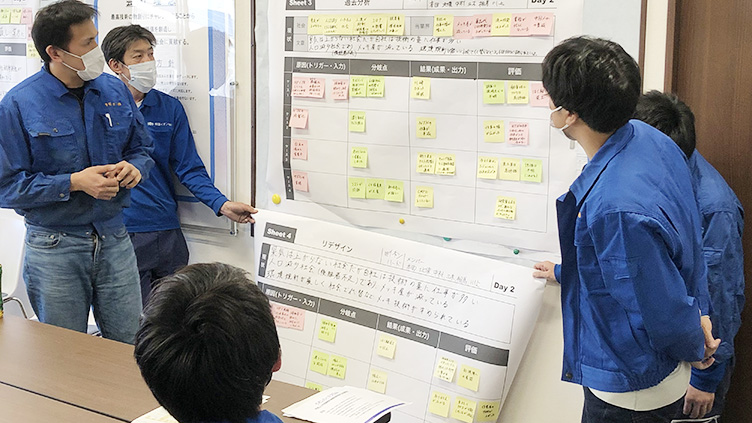
Reference
─
- Hara K, Future Design and Industrial Innovatoin, , RIETI Special Report, 2024
https://www.rieti.go.jp/en/special/policy-update/118.html - Fujita K, Kurashiki T, Hara K, Nakamura T, Ikeda J, Analysis of the Impacts of External Evaluation and the Lasting Effects of Future Design Workshop, Journal of JSEE, 5_2 - 5_9, 2024 (In Japanese)
https://doi.org/10.60316/jcossar.10.0_301 - Fujita K, Tanahara W, Kurashiki T, Hara K, Ikeda J, Nakamura K, A Study on the Effectiveness of Workshops for Proposition of Sustainable Business Based on Future Design, Proceedings of the Japan Conference on Structural Safety and Reliability 2023, 301-307 (In Japanese)
https://doi.org/10.60316/jcossar.10.0_301 - Fujita K, Kurashiki T, Hara K, Ikeda J, Nakamura T, Analysis of the Effects of Adopting "Imaginary Future Generations" on the Design of Technology Development and Business Proposal - Case Study of Workshop at a Plating Processing Company, Proceedings of EcoDesign 2023, 955-962, 2023
- Article by Nikkei Shinbun (in Japanese)
━━ Case:03
Corporate New Business Proposals
Food Industry / 2020
The consideration of business proposals and management strategies in companies from a long-term perspective is important in terms of sustainable management and social contribution. Recently, there have been studies of the effects of adopting Future Design in corporate’s new business proposals. In this practice, Future Design was introduced to the discussion and decision-making process among corporate stakeholders on the theme of new business proposals related to food in 2040, and the effects of the introduction of Future Design were verified. In discussions and decision-making from the perspective of Imaginary Future Generations (IFGs), it is confirmed that the scope of stakeholders in the business proposal was expanded, with greater emphasis placed on customers and key partners, compared to when the proposal was examined from the perspective of current generation. We also found that proposals from the perspective of IFGs could be valued by managers within the company.
Reference
─
- Hosomi T, Kondo G, Wakamoto K, Hara K, Kurashiki T, Analysis of the effectiveness of adopting Future Design on new business proposals from the perspective of future generations - A case study of a company, The Journal of Science Policy and Research Management,38(1), 113-129, 2023 (in Japanese)
https://doi.org/10.20801/jsrpim.38.1_113
━━ Case:04
Industry-academia-government members discuss action plan for introducing renewable energy
Industry-academia-government members / 2024
The Kyoto Miraimon Project (Representative: Assoc, Prof. Takuro Kobashi of Tohoku University), which discusses the realization of carbon neutrality in Kyoto City with members from industry, academia, and government, conducted a Future Design practice to study measures to achieve carbon neutrality in Kyoto City in 2024 and specific projects to be undertaken immediately thereafter. The project is expected to be completed in 2024. Osaka University research members (Prof. Keishiro Hara, Assoc. Prof. Yutaka Nomaguchi), who have academic knowledge of Future Design, supported the design of the discussion. By taking a bird's eye view of various aspects, including tourism, transportation, energy, citizen lifestyles, buildings, and green space use, members proposed measures to be taken by 2030 to achieve both carbon neutrality and improved urban attractiveness in 2050. Four discussions were held online to discuss proposals for measures to be taken by 2030, a roadmap to 2050, and an action plan to achieve both carbon neutrality and improved urban attractiveness by 2050.
The participating members were from academia (Osaka University in charge of Future Design discussion design, researchers from Tohoku University, University of Tokyo, and National Institute for Environmental Studies), public institutions (Kyoto City, Kyoto City Environmental Conservation Promotion Association), and industry (mainly corporate executives related to solar power generation). Discussions were held on the implementation of specific projects, mainly on the introduction of renewable energy, from the viewpoint of Imaginary Future Generations.
Another feature of this practice is that the “causal loop diagram,” a tool of systems thinking, was introduced in the design of the roadmap to 2050 to discuss specific measures and to identify projects and action plans. By introducing the perspective of Imaginary Future Generations, the discussion and decision-making of concrete measures and project formation by diverse stakeholders from industry, academia, and government will become increasingly important in the future for creating new innovations that will lead to the transformation to a sustainable society.
Reference
─
- Yutaka Nomaguchi, Takuro Kobashi, Keishiro Hara (2025) Future Design Practice for Creating an Action Plan toward Carbon Neutrality in a Local City: A Case Study of the Kyoto Miraimon Project, Proceedings of EcoDesign 2025
━━ Case:05
Examination of a sustainable society in 2050 and the role of digital by companies from different industries
Companies from Different Industries, Local Governments, University Students / 2024
The NEC Kansai Regional Co-creation Programme, in collaboration with the Hara Laboratory, Graduate School of Engineering, Osaka University, conducted Future Design to discuss issues relating to the nature of a sustainable future society and the role of digital technology. In addition to the objective of enabling industrial stakeholders to learn about Future Design, this project was also conducted as part of the lecture "Future Design" of the Osaka University’s doctoral program “Cross-Boundary Innovation Program.”
Employees from 9 companies from different industries participating in the Kansai Region Co-creation Programme, officials from one local government and undergraduate and postgraduate students from Osaka University participated as mixed teams and discussed the state of the future society in 2050, measures to be taken within the next five years to address the three issues of climate change and disaster, wellbeing and healthcare, and the role of digital in these measures, all from the perspective of the ‘Imaginary Future generations’. By examining the issue from the perspective of the future generation, new policy proposals, issues and risks to be considered in the future, and awareness of new values that could be shared in a future society were widely discussed.
Future design research suggests that sharing the perspectives of future generations can increase the potential for collaboration and motivation for collaboration across organizational and positional boundaries. The project has become a valuable opportunity to go beyond learning. Designing new directions for industrial innovation towards a sustainable society is likely to become increasingly important in the future, and Future Design could form the basis for this.
Reference
─
- In preparation
━━ Case:06
Design of Pharmaceutical R&D Strategy
Nippon Shinyaku CO., LTD/2024
Nippon Shinyaku implemented Future Design in collaboration with the Hara Laboratory of the Graduate School of Engineering, Osaka University, on the theme of designing R&D strategies for pharmaceuticals and drug discovery. Twenty-five employees from various research groups participated in six rounds of discussions to examine the state of society and business in 2050 and the direction of R&D themes and innovations to be undertaken in the future, even from the perspective of the Imaginary Future Generations (IFGs). Before introducing the perspective of IFGs, we also analyzed and evaluated past R&D strategies of the company.
In this joint research, we are also examining the possibility and effectiveness of redesigning the direction of innovation (redesign) by examining company business and R&D strategies from the perspective of future generations, based on the results and data of the practice. Through this Future Design practice, it has been indicated that the participating employees' awareness of future company business has changed and that they have become more proactive and motivated in their R & D proposals.
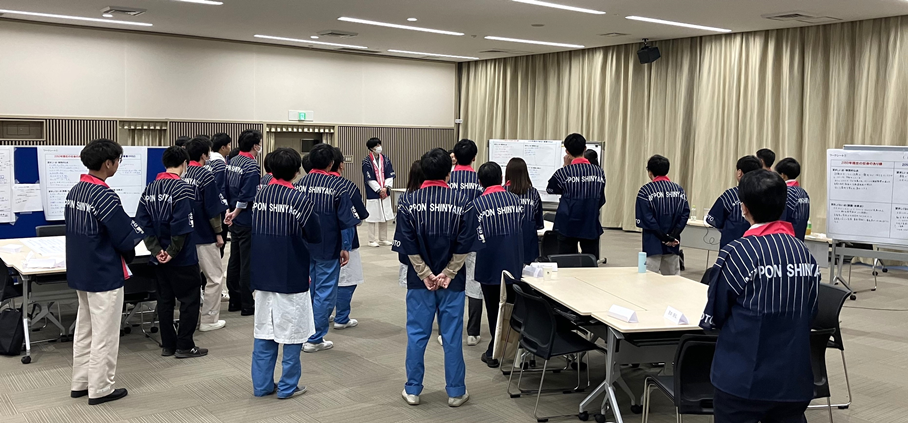
Reference
─
- In preparation
━━ Case:07
Envisioning the energy system in the Kansai region in 2060
The Kansai Electric Power Co., Inc./2025
The future of energy infrastructure, the technological systems required to realize it, and the institutional design must be examined from a long-term perspective. In particular, when considering the future of energy demand and supply in society from the perspective of sustainability, and when developing the necessary policies (technology, mechanisms, systems, etc.), it is essential to take into account the perspective of future generations.
The Mobility System Joint Research Chair at Graduate School of Engineering, The University of Osaka, has set “Future Design” research and practice as one of the pillars of its second phase (2025–) research plan. In the first year of the 2025 fiscal year, with the participation of employees from the Kansai Electric Power Co., Inc., the program is conducting Future Design to examine the energy system of the Kansai region in 2060 from the perspective of future generations and to propose and select measures to be taken in the future. In particular, five key areas related to energy—mobility, housing, industry, values related to energy, and lifestyle—have been identified, and the energy infrastructure and supply-demand dynamics in the Kansai region by 2060 are being examined. Additionally, effective tools such as causal loop diagrams are being utilized to concretize the consideration of these policies.
Starting in the 2026 fiscal year, we plan to build on the Future Design approach, incorporating modeling techniques to more precisely envision the future of energy and mobility by 2060. We also aim to deepen our examination of the technologies and systems necessary to achieve a sustainable energy system.
Reference
─
- In preparation
━━ Case:08
Consideration of Research and Development Strategies and Roadmaps for Environmental Technologies
Kobelco Eco-Solutions Co., Ltd. / 2025
The development of technologies related to the environment and resource recycling, and their implementation in society, are extremely important for the realization of a sustainable society. Shinko Environmental Solutions, which promotes technological development and related businesses in the environmental field, has been implementing Future Design for research and development strategies and roadmap design since fiscal 2025 as part of a joint research project with the Hara Laboratory at The University of Osaka. Looking ahead to a 2050 society, the company is examining the direction of technology and research and development from the perspective of Imaginary Future Generations, while also implementing concrete roadmap design to achieve these goals.
Additionally, in the Future Design practice, we are analyzing the effectiveness of adopting Future Design from the perspective of human resource development. Previous Future Design research has suggested that examining the direction of innovation from the perspective of future generations can foster long-term perspectives, innovative viewpoints, and heightened motivation for transformation. In this practice, we aim to comprehensively verify the effectiveness of Future Design for human resource development, building on the results of existing research.
Reference
─
- In preparation
━━ Case:09
Designing business strategies and supporting systems in the energy sector
Chubu Electric Power Miraiz Company, Inc./ 2025
This Future Design practice is being conducted as part of a joint research project between Chubu Electric Power Miraiz Company, Inc. and the Hara Laboratory, Graduate School of Engineering at The Unviersity of Osaka. It aims to design business strategies and the necessary systems to achieve them, focusing on the sustainability of businesses and their impact on society, particularly in relation to energy-related businesses in the Chubu region.
Employees from various departments of the company are participating in this practice, broadly examining business strategies and innovation directions from the perspective of future generations, and designing the systems that will be required in the future. Additionally, through the practice, we are examining its effectiveness from the perspectives of literacy acquisition and human resource development, including the cultivation of long-term perspectives, creativity, and motivation for transformation.
Reference
─
- In preparation
Other Practices (Education, R&D strategy)
━━ Case:01
Exploring Future Issues and Needs by Company Employees and University Students
Companies from Different Industries and University / 2022
Employees from five major Japanese companies in different industries and students (undergraduate and graduate students) from Osaka University joined together to discuss and explore the nature, challenges, and needs of a society in 2050 that has achieved resilience to global risks and maintenance of wellbeing and health. In addition, the Causal Loop Diagram, a tool of systems thinking, was used to organize the causal relationships of issue groups from a bird's eye view and extract the essential issues. This is the first practice in which companies from different industries and students jointly examined the problems of the future society through Future Design.
This case also suggests that a compatible effect of Future Design and systems thinking (Causal Loop Diagram) can be expected.
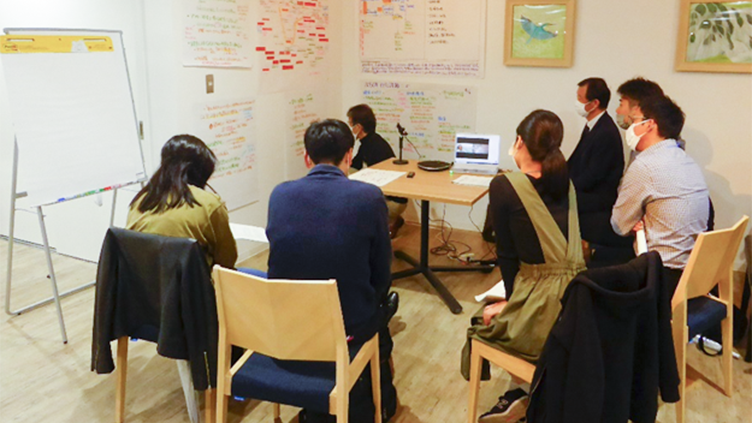
Reference
─
- Hara K, Fuchigami Y, Arai T, Nomaguchi Y, Compatible Effects of Adopting Imaginary Future Generations and Systems Thinking in Exploring Future Challenges - Evidence from a Deliberation Experiment, Futures & Foresight Science, e191, 2024
https://doi.org/10.1002/ffo2.191
━━ Case:02
Educational Program on Future Design at Graduate Schools
University / 2019 -
At Osaka University, members involved in the development of the concept of Future Design introduced an exercise adoting "Imaginary Future Generations" for the first time in a lecture in 2012. Osaka University now offers lectures on "Future Design" in the Graduate School of Engineering and Cross-Boundary Innovation Program (picture below), where students have the opportunity to learn systematically about Future Design. For example, this program at the Graduate School of Engineering is to learn Future Design systematically, including the background of Future Design, basic ideas (theory), examples of application to various issues, group exercises, and lectures by practitioners such as those in Yahaba town which first adopted Future Design. In 2023, graduate students attending the Cross-Boundary Innovation Program discussed policies for forestry management in view of a society in 2050 from the perspective of Imaginary Future Generations.
In addition, the "Frontiers of Sustainability Science," an intensive course in English offered in collaboration with Osaka University, the University of Tokyo, Kyoto University, Ibaraki University, and the United Nations University, connects the five universities online and provides lectures and exercises on Future Design together with international students. In academic years 2022 and 2023, students learned the significance of examining issues and measures from the perspective of Imaginary Future Generations (IFGs) through group exercises on Future Design toward the realization of carbon neutrality in 2050.
(As a reference example, the Planetary Health Japan Hub of the Planetary health Alliance organized a student-led workshop incorporating Future Design concepts, focusing on intergenerational issues within the planetary health field.)
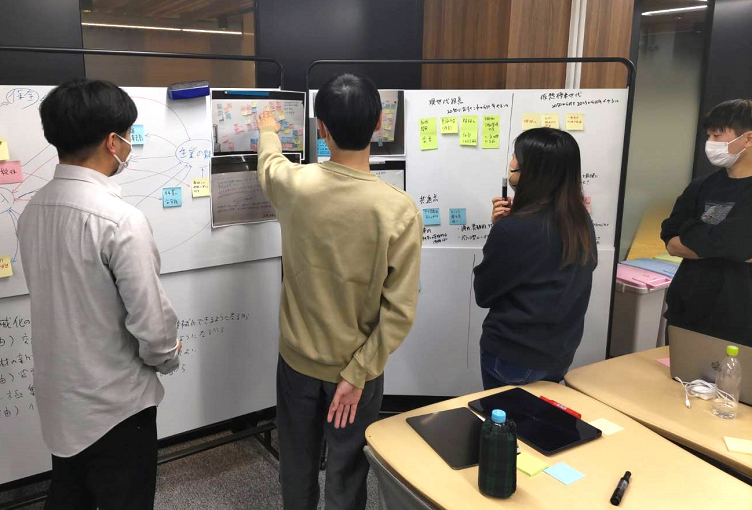
Reference
─
- Hara K, Onuki M, Uwasu M, Tamura M, Kotera A, Pu J, Jarzebski M.P, Kameyama Y, Sustainability Education Incorporating Intergenerational Issues: A Case Study of an Online-Based Program in Inter-University Curricula Adopting the Future Design Method, SSRN (preprint), 2025
https://papers.ssrn.com/sol3/papers.cfm?abstract_id=5248379 - Uwasu, M., Kishita, Y., Hara, K., Shen, J., Kuroda, M., Takeda, H and Saijo, T (2015) Future design - How to create future generations in visioning? , Proceedings of EcoDesign 2015, pp. 67-71
━━ Case:03
Future Design in Education at High Schools
High School / 2018 -
Through research and practice, Future Design has been shown to be effective in human resource development and education. In particular, it has been suggested to be effective in gaining new perspectives and fostering sustainable decision-making and judgment. Not only in universities, but also in high school classes and extracurricular activities, group discussions using Future Design are being held on a variety of themes, such as disaster prevention and the future of high schools. Researchers from Osaka University and other universities also provide support, creating opportunities for students to consider various social issues and familiar problems from the perspective of future generations as part of their classes and extracurricular activities.
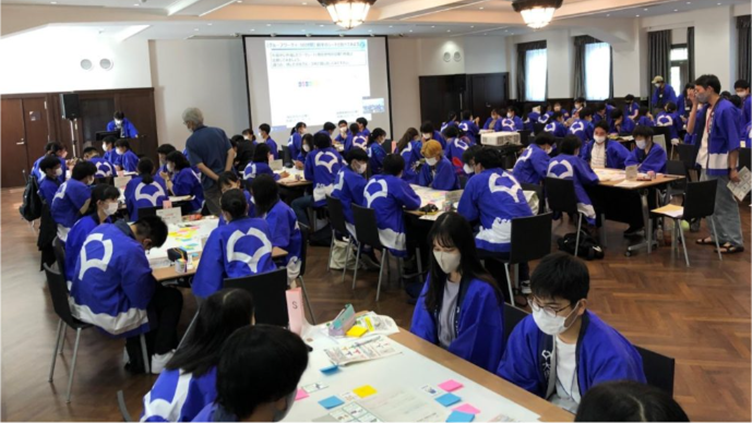
Reference
─
━━ Case:04
Exploring Academic Research Agenda ‐Case of Material Technologies
University / 2019, 2020
Previous Future Design research has suggested that the adoption of Imaginary Future Generations (IFGs) can provide a new direction for academic research and technological innovation from a long-term or sustainability perspective. To address this issue, members (faculty and students) of the Interface Science and Technology Area of the Division of Materials and Manufacturing Science, Graduate School of Engineering, Osaka University, in collaboration with the Hara Laboratory of the same Graduate School of Engineering, are working on the themes of "social adoption of hydrothermal technology in the future" (2019, 2020) applying Future Design method. As a result, we found that the relative value of the targeted technologies and the conditions for social implementation change according to the social conditions described from the perspective of IFGs. It is found that it is possible to define new directions for technological innovation.
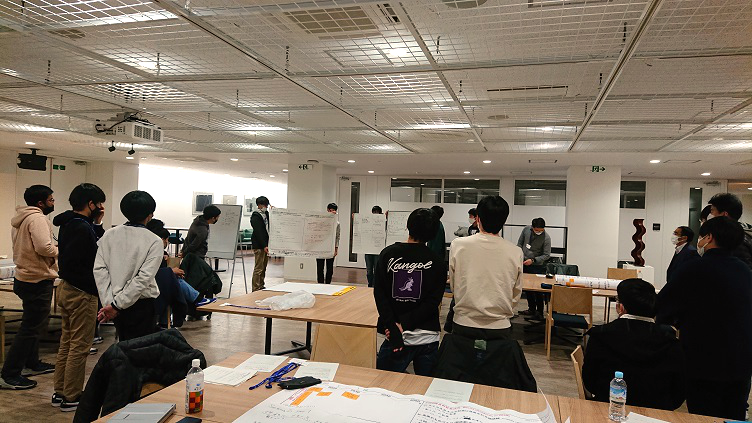
Reference
─
- Hara K, Miura I, Suzuki M, Tanaka T, Designing Research Strategy and Technology Innovation for Sustainability by Adopting “Imaginary Future Generations”?A Case Study Using Metallurgy, Futures and Foresight Science, 5(3-4), e163, 2023
https://doi.org/10.1002/ffo2.163 - Hara K, Miura I, Suzuki M and Tanaka T (2023)Assessing Future Potentiality of Technology Seeds from the Perspective of“Imaginary Future Generations”? a Case Study of Hydrothermal Technology, SRRN (preprint)
http://dx.doi.org/10.2139/ssrn.4156316
━━ Case:05
Designing Research Strategies for Sustainable Supply Systems of Metals
University / 2022
In response to various sustainability issues, such as climate change and resource depletion, the goals of carbon neutrality, sustainable resource use, and a circular economy have become vital and urgent international challenges. To achieve the social goal of carbon neutrality by 2050, industrial material manufacturing processes are expected to use electricity instead of fossil fuels for heating. We also expect to see growing use of solar, wind, and other forms of renewable power generation infrastructure, high-capacity lithium-ion batteries and other kinds of secondary batteries, and electric vehicles (EVs) equipped with high-output motors. Further advances in sensing and information processing technologies are also essential for realizing the smart city concept. In response to the growing demands of rare metals, reliable sources and supplies of various rare metal are required.
Given this background, we aimed to clarify the R&D and technological challenges that may arise in the future by conducting deliberation in which participants (i.e., faculty members and students of the Interface Science and Technology Area of the Division of Materials and Manufacturing Science, Graduate School of Engineering, Osaka University) examined the supply and demand of rare metals in a future society, along with associated research topics, adopting the method of Imaginary Future Generations (IFGs). It is found from the practice that incorporating the views of IFGs could provide insights into the new directions and requirements of technological innovation for managing rare metal supply and demand.
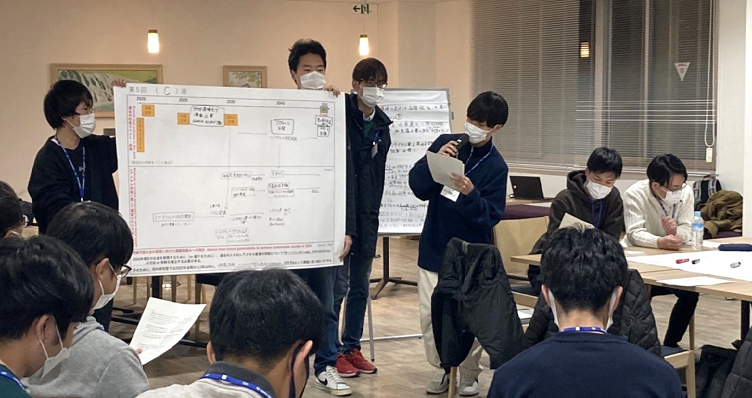
Reference
─
- Hara K, Arai T, Liao Z, Ifuku N, Suzuki M, Designing Research and Development Strategies for Sustainable Supply Systems of Rare Metals from the Perspective of“Imaginary Future Generations”– A Participatory Deliberation Experiment, Journal of Cleaner Production, 486, 144445, 2025
https://doi.org/10.1016/j.jclepro.2024.144445
━━ Case:06
Evaluation of research and development policies for CO2 resource utilization technolog
University / 2025
As climate change becomes increasingly serious, “CO2 resource utilization technology” is gaining attention as part of measures to combat global warming. CO2resource utilization technology aims to collect and reuse CO2 that has been emitted into the atmosphere and contributed to global warming, ultimately converting it into other resources. This technology is attracting international attention for its potential to reduce CO2 in the atmosphere and contribute to carbon neutrality, and research and development is progressing.
However, there are challenges in the process of implementing these promising research and technologies into society. It is necessary to specifically understand the future society where CO2 resource utilization technology is implemented, the technological needs within that society, and the challenges of implementation, in order to consider the direction of future research and development. It is considered effective to evaluate these perspectives from the viewpoint of future generations.
Against this backdrop, the Nakanishi Laboratory at the Graduate School of Engineering Science, The University of Osaka, which is advancing research on CO2 resource utilization technology, and the Hara Laboratory at the Graduate School of Engineering, The University of Osaka, which is advancing research and practice in Future Design, collaborated to conduct a future design practice on “Establishing a Research Policy for the Development and Realization of CO2 Resource Utilization Technology with a View to Society in 2055.” Undergraduate and graduate students involved in CO2 resource utilization technology-related research participated in the project, examining the state of society in 2055, the needs for CO2 resource utilization technology in that society, and the challenges of social implementation from the perspective of a Imaginary Future Generation, and considering research and development themes to be pursued in the future.
A distinctive feature of this practice was the analysis of innovation trends over the past few decades in relation to socio-economic conditions, based on a database of 2 resource utilization technology research and development, and the application of these insights to the Future Design practice.
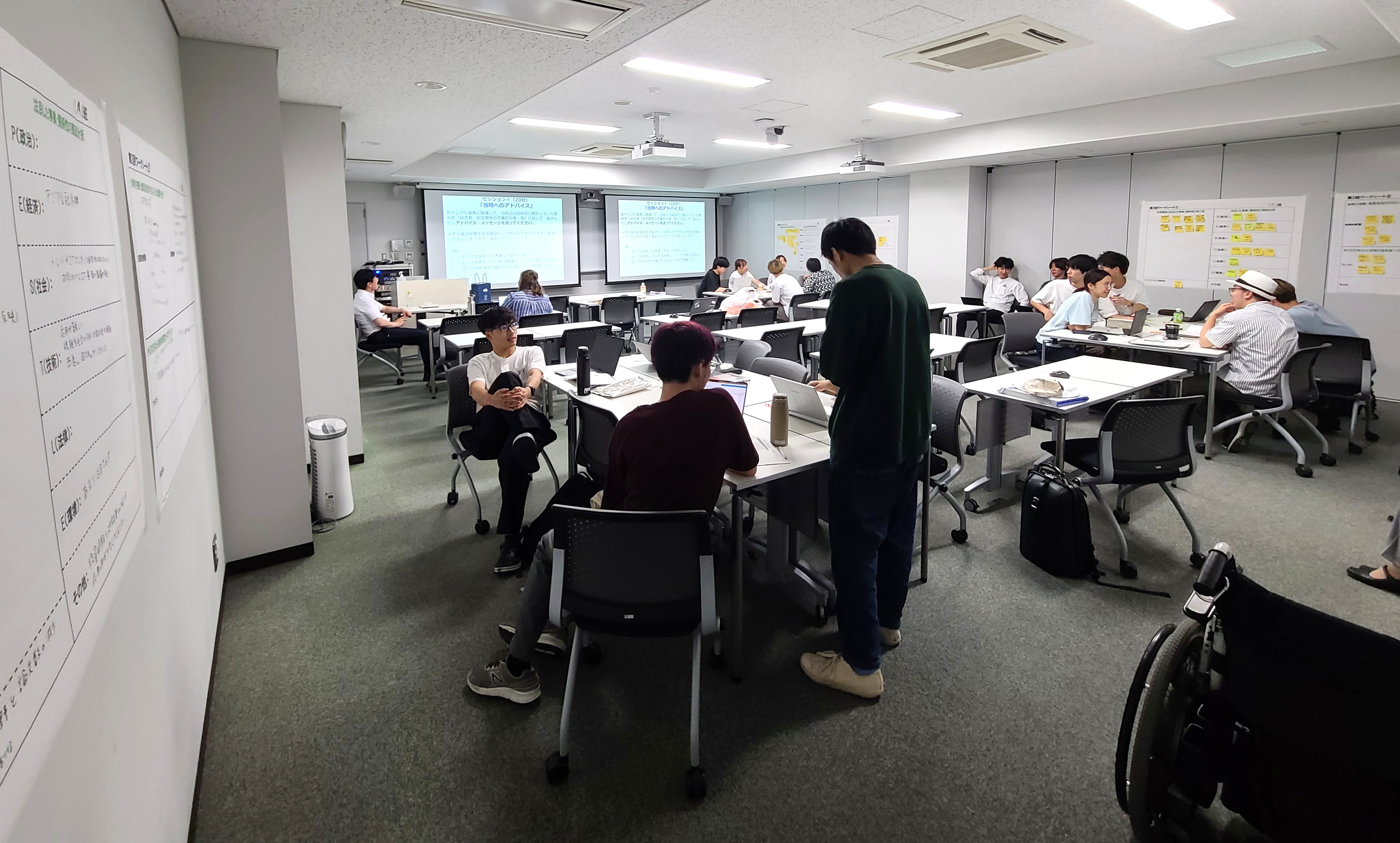
Reference
─
- Kenichiro Takenaga, Hiro Tabata, Shuji Nakanishi, Keishiro Hara (2025) Retrospective Analysis and its Application to Future Design for Research and Development - A Case Study of CO2 Resource Utilization Technologies, Proceedings of EcoDesign 2025



